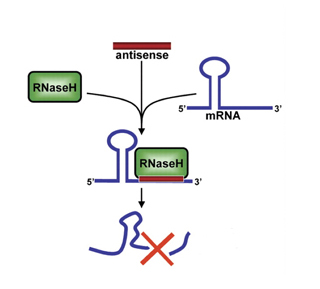
Search and destroy. Antisense oligonucleotides directed against the repeat expanded form of C9ORF72 RNA bind these potentially toxic molecules - tagging them for destruction. Image: Courtesy of Rockefeller University Press.
Repeat expansions in the C9ORF72 gene appear to be the most common cause of ALS identified to date – potentially explaining nearly 40% of cases of the inherited form of the disease. Researchers, however, remain unsure why these repeat sequences within the first intron of the gene trigger ALS.
Some scientists suspect that the repeat expanded C9ORF72 RNA might act as a sponge – soaking up transcription factors in motor neurons needed to keep these muscle-moving cells healthy. But the loss of function of C9ORF72 alone could also potentially result in the disease.
Researchers hope to distinguish these possibilities by developing human induced pluripotent stem cell (iPS) and mouse models of C9ORF72-linked ALS and studying the underlying mechanism of the disease.
A growing number of scientists, however, are hedging their bets by developing antisense-based strategies that reduce these potentially toxic RNAs in hopes to create a treatment more quickly for this form of ALS. These small oligonucleotides, called gapmers, bind specifically to these repeat expanded RNA molecules – intracellularly targeting them for destruction.
ALS Today‘s Michelle Pflumm PhD talked to Johns Hopkins University School of Medicine neurologist Jeff Rothstein MD PhD about C9ORF72 and potential treatments for this form of ALS going forward.
To learn more about C9ORF72, check out our interactive timeline.